
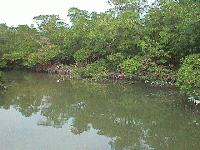
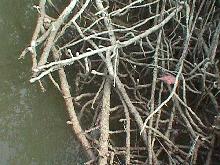
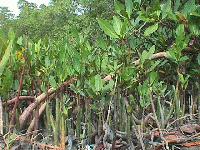
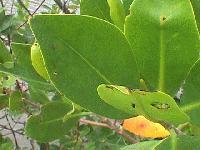
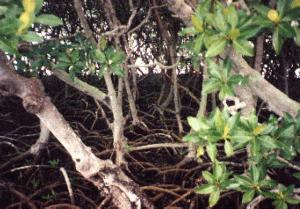
Red Mangroves (Rhizophora mangle)
The red mangrove is the most noticeable of the three Florida mangrove trees. It grows in the deepest water and its arching prop roots support the tree above the water as if it were walking on stilts. Wart-like lenticels on these prop roots provide openings where oxygen can be taken in and pumped through the system to the underground roots growing in the anaerobic mud. Since red mangroves grow close together, their roots form an impenetrable tangled network which slows down the movement of water underneath the trees. This causes a deposition of sediment and traps an enormous collection of debris. This build up of sediment and debris under the right conditions can create a thick layer of organic peat.






The leathery evergreen leaves of the red mangrove form a dense canopy which are highly efficient in converting sunlight to organic molecules. Sprinkled in among the leaves are yellow and white flowers. The red mangroves have an unusual reproductive adaptation enabling the seedling to survive in the watery environment. The seed germinates from the fruit while it is still attached to the parent tree. Many fruits with finger-like seedlings, often twelve or more inches in length, can be seen hanging in clusters. When mature, the seedlings break free from the fruit and fall into the water. Some may stick in the soft mud around the base of the parent tree and begin to grow. Many more float around with the tide. After floating in the water for a short period of time, the pointed end absorbs water and begins to sink. When the seedling becomes grounded in the mud. roots are quickly produced from the pointed end and the seedling begins to put out leaves.
